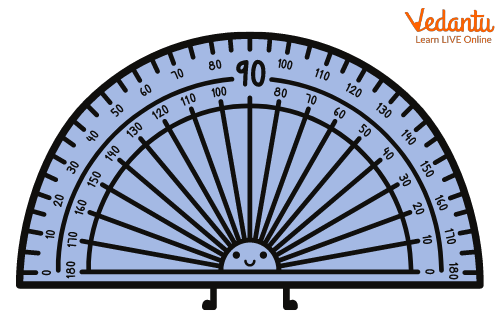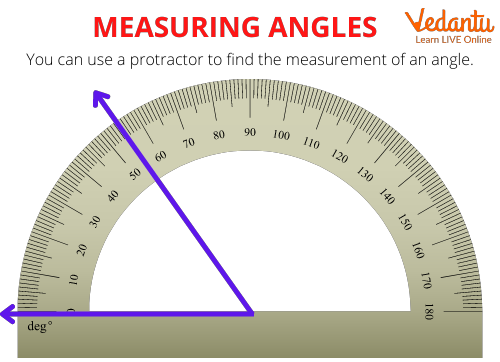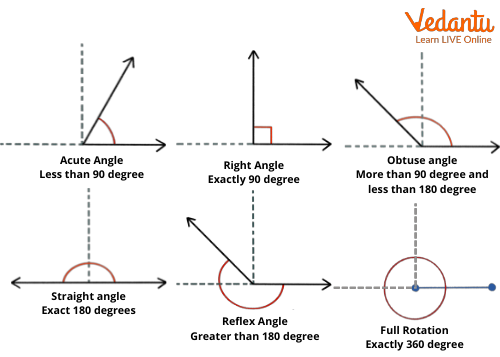




Introduction to Angle Measurement
Before understanding the angle measurement methods kids must understand what an angle is. The angle is defined as the geometrical shape that is the resultant of the joining of two lines at their ends. Acute angle, obtuse angle, right angle, straight angle, reflex angle and full rotation angle are the angles that are taught to kids to help them better understand the concepts of geometry and as their grades progress the understanding of angles play a crucial role in the understanding of trigonometry. In this article, we are focused on providing the students with a short description of the common angles and the methods of angle measurement. Let us start our discussion by looking into how angles are measured?
How is Angle Measurement Performed?
As we know angles are the geometrical shape that is formed by adjoining rays in an end to end fashion, this leads to the formation of inclination. The angle measurement is done in degrees. Now it is important for kids to note that this degree is the unit of measurement of angle. Kids must not confuse it with the measurement of the temperature. As the temperature is also measured in degrees Celsius and degrees Fahrenheit. The angle measurement is done with the help of a geometrical tool named a protractor.
Protractor
As defined earlier protractor is defined as the tool used to measure the angles. The protractor is a semi-circle in shape. The tool is divided into equal parts which represent angles from 0 degrees to 180 degrees. It is important to note that a protractor has two readings, the inner and outer measurements are in opposite directions. The image mentioned below helps in a better understanding of the measurements of the protractor.

Image illustrating the protractor measurement units
Measuring Angle Using a Protractor
For measuring an angle using a protractor students must place the protractor on the vertex of the angle. The base of the proctor must be aligned with the base of the angle. The angle is then measured by counting from 0 up to the point where the ray intersects. It can be better understood by the diagram mentioned below.

Measuring angle using the protractor
The image illustrates that the angle is 55 degrees.
Note- One of the most important points while performing angle measurement is to start the counting from zero degrees of the protractor scale. As in the example illustrated above, if the angle is measured by counting from 180 degrees, the angle measurement would have been 125 degrees, which is wrong.
Types of Angles
Since we have learnt how to measure angles, let us look into the six types of angles.
Acute Angle
The angles that lie between 0 to 90 degrees are categorized as acute angles.
Obtuse Angle
The angle that lies between 90 to 180 degrees is said to be the obtuse angle, they are in a sense opposite to the acute angles.
Right Angle
The right angle is defined as 90 degrees. 91 degrees is considered an obtuse angle whereas 89 degrees is considered to be an acute angle.
Straight Angle
The angle that is 180 degrees is known as the straight angle.
Reflex Angle
An angle that is between 180 to 360 degrees is termed a reflex angle. It is greater than 180 degrees but is lesser than 360 degrees.
Full Rotation Angle
It is the angle whose measurement is 360 degrees, they are formed by the complete rotation of the ray. The image illustrated below represents all the angles discussed above.

Image illustrating the different angles
In conclusion of the article, we have learnt about the angle measurement method using a protractor. We have also learnt about the various angles and their definitions. We hope that the study material provided will help students excel in geometry classes.
FAQs on Angle Measurement
1. How do you correctly measure an angle using a protractor?
To measure an angle with a protractor, you must follow these steps as per the standard geometrical method:
- Place the center point of the protractor directly on the vertex (the corner) of the angle.
- Align the base line of the protractor (the 0° line) with one of the arms of the angle.
- Read the measurement on the protractor scale where the second arm of the angle intersects it. Always start counting from the 0° mark, not 180°.
2. What are the main types of angles based on their measurement?
In geometry, angles are primarily classified into six types based on their degree measurement:
- Acute Angle: An angle that measures between 0° and 90°.
- Right Angle: An angle that measures exactly 90°.
- Obtuse Angle: An angle that measures between 90° and 180°.
- Straight Angle: An angle that measures exactly 180°.
- Reflex Angle: An angle that measures between 180° and 360°.
- Full Rotation Angle: An angle that measures exactly 360°.
3. What is a vertex in the context of an angle?
A vertex is a fundamental concept in geometry, defined as the common point where two lines or rays meet to form an angle. When measuring an angle, the protractor's central point must be aligned with this vertex for an accurate reading. The two lines that form the angle are called its arms or sides.
4. What are the special names for angles measuring exactly 90°, 180°, and 360°?
Angles with these specific measurements have unique names in geometry:
- An angle of 90° is called a right angle.
- An angle of 180° is called a straight angle, as it forms a straight line.
- An angle of 360° is called a full rotation or complete angle.
5. Why does a protractor have two sets of numbers (an inner and outer scale)?
A protractor has two scales to provide flexibility when measuring. The dual scales, running in opposite directions, allow you to measure an angle from either the left or the right side without turning the protractor upside down. You simply choose the scale that starts at 0° on the base arm of your angle, ensuring a correct and direct measurement.
6. What is the difference between a positive and a negative angle?
The sign of an angle is determined by its direction of rotation from a base line. A positive angle is formed when the rotation is in an anticlockwise direction. Conversely, a negative angle is formed when the rotation is in a clockwise direction. This concept becomes particularly important in higher-level topics like trigonometry.
7. Why is it a mistake to read from the 180° mark when measuring an acute or obtuse angle?
Starting your measurement from the 180° mark instead of the 0° mark is a common error that measures the wrong angle. An angle represents the amount of turn or inclination between two lines from a common point. The 0° mark represents the starting point of this turn. If you start from 180°, you are actually measuring the supplementary angle (the angle that adds up to 180° with your target angle), which will result in an incorrect value.









